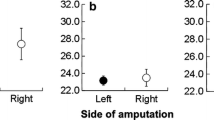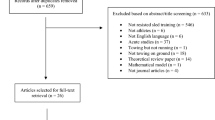Abstract
Purpose
Although sprinters with unilateral (UTF) and bilateral transfemoral (BTF) amputations and functional impairments (FIs) without amputation were allocated into different classifications because of the recent revision of the International Paralympic Committee Athletics Rules and Regulations, it is unclear whether running mechanics differ among the three groups. The aim of this study was to investigate the differences in the spatiotemporal parameters of the three groups during 100-m sprint in official competitions.
Methods
Using publicly available Internet broadcasts, we analyzed 11 elite-level sprinters with UTF amputation, 4 sprinters with BTF amputation, and 5 sprinters with FI without amputation. The best personal times for nearly all individuals were included. For each sprinter’s race, the average speed, step frequency, and step length were calculated using the number of steps in conjunction with the official race time.
Results
Although there were no significant differences in the average speed among the UTF, BTF, and FI groups (7.95 ± 0.22, 7.90 ± 0.42, and 7.93 ± 0.14 m/s, respectively, p = 0.87), those with BTF amputation showed significantly lower step frequency (UTF: 4.20 ± 0.20 Hz, BTF: 3.71 ± 0.32 Hz, FI: 4.20 ± 0.10 Hz, p < 0.05) and longer step length (UTF: 1.90 ± 0.08 m, BTF: 2.14 ± 0.02 m, FI: 1.89 ± 0.06 m, p < 0.05) than the other two groups.
Conclusion
These results suggest that the step characteristics during sprinting are not the same among sprinters with UTF amputation, BTF amputations, or FI without amputations.



Similar content being viewed by others
Abbreviations
- BTF:
-
Bilateral transfemoral
- ES:
-
Effect size
- FI:
-
Functional impairments
- f step :
-
Average step frequency
- L step :
-
Average step length
- Lf ratio :
-
Step length/step frequency ratio
- N step :
-
Number of steps
- S 100 :
-
Average speed
- t race :
-
Official race times
- UTF:
-
Unilateral transfemoral
References
Barak Y, Wagenaar RC, Holt KG (2006) Gait characteristics of elderly people with a history of falls: a dynamic approach. Phys Ther 86(11):1501–1510
Beck ON, Taboga P, Grabowski AM (2016) Characterizing the mechanical properties of running-specific prostheses. PLoS One 11(12):e0168298
Brüggemann GP, Arampatzis A, Emrich F, Potthast W (2009) Biomechanics of double transtibial amputee sprinting using dedicated sprinting prostheses. Sports Technol 1(4–5):220–227
Buckley JG (1999) Sprint kinematics of athletes with lower-limb amputations. Arch Phys Med Rehabil 80(5):501–508
Callisaya ML, Blizzard L, McGinley JL, Srikanth VK (2012) Risk of falls in older people during fast-walking-the TASCOG study. Gait Posture 36(3):510–515
Cohen J (1988) Statistical power analysis for the behavioral sciences, 2nd edn. Lawrence Erlbaum Associates, Publishers, Hillsdale
Egerton T, Danoudis M, Huxham F, Iansek R (2011) Central gait control mechanisms and the stride length–cadence relationship. Gait Posture 34(2):178–182
Eke-Okoro ST (1999) Exploration of paretic gait by differential loading in normals. Clin Biomech 14(2):136–140
Hobara H, Kobayashi Y, Mochimaru M (2015) Spatiotemporal variables of able-bodied and amputee sprinters in men’s 100-m sprint. Int J Sports Med 36(6):494–497
Hobara H, Potthast W, Müller R, Kobayashi Y, Heldoorn TA, Mochimaru M (2016) Normative spatiotemporal parameters during 100-m sprints in amputee sprinters using running-specific prostheses. J Appl Biomech 32(1):93–96
Hobara H, Potthast W, Müller R, Kobayashi Y, Hashizume S, Heldoorn TA, Mochimaru M (2017) Relationship between body height and spatiotemporal parameters during a 100 m sprint in able-bodied and unilateral transtibial sprinters. Prosthet Orthot Int 41(5):492–497
Hobara H, Saito S, Hashizume S, Namiki Y, Kobayashi Y (2018) Differences in spatiotemporal parameters during 200-m sprint between bilateral and unilateral transfemoral amputees. Prosthet Orthot Int. https://doi.org/10.1177/0309364618767142
Howard C, Wallace C, Stokic DS (2013) Stride length–cadence relationship is disrupted in below-knee prosthesis users. Gait Posture 38(4):883–887
Hunter JP, Marshall RN, McNair PJ (2004) Interaction of step length and step rate during sprint running. Med Sci Sports Exerc 36(2):261–271
IPC Athletics Rules and Regulations 2016–2017
Jarvis HL, Bennett AN, Twiste M, Phillip RD, Etherington J, Baker R (2017) Temporal spatial and metabolic measures of walking in highly functional individuals with lower limb amputations. Arch Phys Med Rehabil 98(7):1389–1399
Kuitunen S, Komi PV, Kyröläinen H (2002) Knee and ankle joint stiffness in sprint running. Med Sci Sports Exerc 34(1):166–173
Makimoto A, Sano Y, Hashizume S, Murai A, Kobayashi Y, Takemura H, Hobara H (2017) Ground reaction forces during sprinting in unilateral transfemoral amputees. J Appl Biomech 33(6):406–409
Nagahara R, Matsubayashi T, Matsuo A, Zushi K (2017) Alteration of swing leg work and power during human accelerated sprinting. Biol Open 6(5):633–641
Rota V, Perucca L, Simone A, Tesio L (2011) Walk ratio (step length/cadence) as a summary index of neuromotor control of gait: application to multiple sclerosis. Int J Rehabil Res 34(3):265–269
Salo AI, Bezodis IN, Batterham AM, Kerwin DG (2011) Elite sprinting: are athletes individually step-frequency or step-length reliant? Med Sci Sports Exerc 43(6):1055–1062
Sekiya N, Nagasaki H (1998) Reproducibility of the walking patterns of normal young adults: test–retest reliability of the walk ratio (step-length/step-rate). Gait Posture 7(3):225–227
Senefeld J, Joyner MJ, Stevens A, Hunter SK (2016) Sex differences in elite swimming with advanced age are less than marathon running. Scand J Med Sci Sports 26(1):17–28
Vrieling AH, van Keeken HG, Schoppen T, Otten E, Halbertsma JP, Hof AL, Postema K (2007) Obstacle crossing in lower limb amputees. Gait Posture 26(4):587–594
Vrieling AH, van Keeken HG, Schoppen T, Hof AL, Otten B, Halbertsma JP, Postema K (2009) Gait adjustments in obstacle crossing, gait initiation and gait termination after a recent lower limb amputation. Clin Rehabil 23(7):659–671
Acknowledgements
This work was supported by JSPS KAKENHI (Grant no. 26702027).
Author information
Authors and Affiliations
Contributions
The study was designed by HH, SH, WP, and RM; HH, SH, YK, and JF wrote the paper with substantial contribution from YN, RM, and WP data were collected by HH. Analyses were performed by HH and SH
Corresponding author
Ethics declarations
Conflict of interest
None of the authors have any conflicts of interest associated with this study.
Additional information
Communicated by Jean-René Lacour.
Rights and permissions
About this article
Cite this article
Hobara, H., Hashizume, S., Kobayashi, Y. et al. Spatiotemporal parameters in sprinters with unilateral and bilateral transfemoral amputations and functional impairments. Eur J Appl Physiol 119, 85–90 (2019). https://doi.org/10.1007/s00421-018-4001-1
Received:
Accepted:
Published:
Issue Date:
DOI: https://doi.org/10.1007/s00421-018-4001-1




